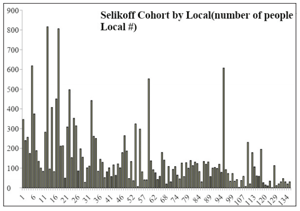Updating the Selikoff Insulator Cohort mortality information
Dr. Andy Todd, MD, DrPH — Tue, Jun 22, 2021 @ 11:06 AM
Efforts to update the Selikoff Insulator Cohort are expected to provide valuable information to better understand the progression of asbestos-related disease. However, before we address this work and what it means, we want to discuss the cohort and what the initial work meant.
Dr. Irving J. Selikoff was a medical researcher who is considered the father of occupational medicine. He is best remembered for his research on asbestos-related illness and for his contributions to the establishment of federal asbestos regulations.
As reported in 1968 in The Journal of the American Medical Association, Dr. Selikoff and his colleagues noticed a striking interaction between occupational exposure to asbestos and cigarette smoking among 370 Insulators in the New York metropolitan area. They estimated that Insulators with a history of both exposures had
in excess of a 90-fold increased risk of death due to lung cancer compared with never-smokers in the general U.S. population not occupationally exposed to asbestos.
Dr. Selikoff’s group at the Mount Sinai School of Medicine went on to study the mortality experience of the entire North American Insulators Union, and in 1979, reported that among 17,800 Insulators followed from 1967 through 1976, there were at least 429 deaths due to lung cancer – with a greater than fourfold increased risk.
Through Dr Selikoff’s work of studying this cohort, the world began to slowly realize the deadly nature of asbestos, as he was the first to describe the full scope of the asbestos-related disease.
The chart below illustrates the members of the Selikoff cohort, by Local Union.

Work performed by Dr. Markowitz to update the mortality (cause-of-death) information for a subset of 2,907 members of the Selikoff cohort has yielded very important findings regarding the role of asbestosis – in addition to that of asbestos exposure and smoking – in the development of asbestos-related disease.
This work to update the mortality information for the entire 17,800 members will likely result in valuable new information, which may help Insulators who have been exposed to asbestos.
Some of the important implications of the work includes updating the 9 percent figure for insulator mortality from mesothelioma, (compared to 0.01 percent for the general population) that everyone assumes has decreased over the years. If the data reveals the mortality rate has not decreased, then we will have an important finding to counter the public (mis) perception that no one is exposed any longer to asbestos.
In addition, Dr. Selikoff did not address exposure quantitatively, and we are working to enhance the cohort information by adding exposure duration from Selikoff’s records (the famous ‘red’ books) and HFIAW records. There are multiple sources containing important and useful information that need to be processed.
Sources from Dr. Selikoff such as the “serum log” and “record of deaths” binders, as well as the “red books,” were evaluated for information and have been entered into electronic versions (which will also preserve them for the future).
An on-going log of death certificates being received from the International is also continuously updated. These records provide new or more accurate information about the cohort members.
Over the past year, we have merged the information from the red books into the cohort, yielding more than 2,000 helpful identifiers such as new or different Social Security numbers (SSN) or name discrepancies.
The serum log binder contributed 823 new identifiers, and the record of deaths has contributed 2,026 identifiers, as well as other useful information such as age, date of death and cause of death. The ongoing death certificate incorporation has contributed 1,944 identifiers, so far, and will continue to provide more information.
In total, these efforts have yielded around 6,000 social security numbers for the cohort of 17,800. Once all of the data has been reconciled from the various sources to the Selikoff cohort, the information will be sent to the NDI (U.S. National Death Index) to get missing death certificates and cause of death. For Canada, we will have to go province-by-province or try to work through Health Canada.
The main reason for all this work is to lay the groundwork for future analyses, which cannot be performed until the cohort mortality information is updated. Multiple sources of records containing helpful information about cohort members have been evaluated and consolidated electronically. Once all the work is finished to update the cohort, then the picture will become clearer about the deadly nature of asbestos and its terrible effect on members of the Insulation industry.